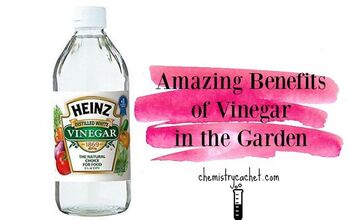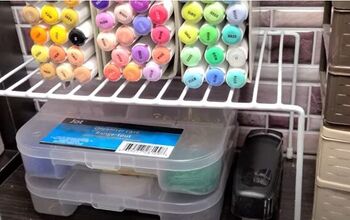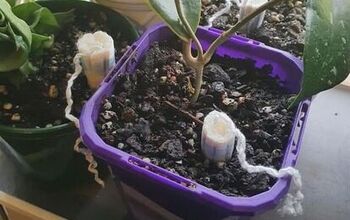How to Grow Vegetables in a Small Garden: Vertical Planters 101

You might think you need a lot of land to grow your own food, cut down on grocery store trips, and have access to fresh, healthy ingredients.
I used to think so too—until I realized that even with just a small deck, it’s possible to create a thriving garden. I live in a townhouse with no yard at all, yet I’ve managed to grow pounds of food in a limited space.
Let me show you how I did it and how you can, too.
My garden set-up
I want to start by saying I’m no expert. I consider myself an intermediate beginner, so if I can grow a flourishing garden, so can you.
My deck garden is the result of trying new things, getting creative with the space I have, and working with a few simple tools and strategies.
This spring, I’ll give you a tour of how I manage to grow a variety of crops, including vegetables, herbs, and flowers, all year round.
On the left side of my deck, I have two GreenStalk vertical planters. One is completely dedicated to herbs, while the other holds leafy greens and root vegetables.
On the right, there are three more planters, each in different stages of growth so I always have something ready to harvest. By staggering the planting times, I can enjoy fresh produce every week, even with a small space.
What to grow in a small garden
Right now, my GreenStalk planters are packed with food, all growing vertically to maximize space. Here's a peek at what I’m growing:
- Texas lantana: A beautiful perennial that flowers from spring to fall.
- Cherry tomatoes: I’ve already got pints of these forming, and they’ll keep producing all summer long.
- Wax begonia: A lovely flower that adds color and vibrancy to the top of the planter.
- Swiss chard & carrots: Swiss chard is a staple for me because it’s heat-tolerant and versatile, and carrots are easy to tuck into the planter’s pockets.
- Herbs: My herb collection includes rosemary, lemon balm, chamomile, parsley, and more. Many of these herbs are perennials, so they come back year after year.
One of the things I love about vertical gardening is that I can plant different crops at different heights.
The lower levels of the planter, for instance, are perfect for shade-loving greens and herbs, which thrive under the cover of taller plants.
This not only helps extend their growing season but also protects them from pests that would normally attack plants at ground level.
Why vertical gardening works so well
You don’t need raised beds or a big garden to grow enough food to feed your family. I discovered that vertical planters, like the ones from GreenStalk, are a game-changer when it comes to maximizing productivity in small spaces.
Before I invested in these, I was using traditional pots and containers, but I quickly ran out of room. Now, with my GreenStalks on wheels, I can move them around my deck to catch the sun or shelter them from bad weather.
The beauty of vertical gardening is that you can grow a lot in a small footprint. Plus, it helps reduce pest issues because your crops aren’t at ground level, where bugs tend to gather.
Harvesting is also super easy—I can just spin the planter and pick fresh herbs, greens, or veggies for cooking. It’s a convenient setup that allows me to enjoy homegrown food every day.
Sustainable practices: low-maintenance, high yields
I’ve been reusing the same potting mix in my planters for six years now, thanks to a few sustainable practices. I focus on keeping the soil healthy by composting, mulching, and adding my own homemade fertilizers.
I also have a worm bin, which produces nutrient-rich worm castings that I mix into the soil at the start of each growing season.
By keeping my soil healthy and alive, I don’t have to buy commercial fertilizers, and it’s better for the environment.
My garden waste, kitchen scraps, and clippings go right back into the soil, closing the loop and keeping everything as natural as possible. With minimal effort, I can maintain productive soil for years.
Overwintering my planters
Even during the winter months, I keep my garden going. I leave my planters outside and cover them with mulch to insulate the soil and protect the roots of my perennials.
This way, I can overwinter crops like Brussels sprouts and Swiss chard, harvesting them throughout the colder months. When spring rolls around, I just refresh the soil with compost and worm castings, and I’m ready to plant again.
Growing without a yard
Vertical gardening has truly given me a sense of freedom. Despite not having a yard, I can grow dozens of crops right on my deck.
Right now, I have over 50 different plants growing, from jalapeños and broccoli to a fig tree — yes, I’m growing a fig tree on my deck! It’s incredibly satisfying to walk outside and pick what I need, whether it’s for a smoothie, salad, or dinner.
Easy, affordable, and accessible
The GreenStalk planter system is affordable and perfect for beginners. You don’t need expensive tools or a huge space to start growing your own food. Vertical gardening is such an efficient way to maximize small spaces, and it’s been a game-changer for me.
Before switching to these planters, I was managing over 60 different containers, which took up all my space. Now, I have a streamlined system that grows more food with less hassle.
How to grow vegetables in a small garden
If you’re thinking about starting a garden, I highly recommend giving vertical gardening a try. Whether you’re growing a few herbs or building a whole vegetable garden, vertical planters allow you to grow more in less space. And the best part is—you don’t need a yard. You can turn any small outdoor space, like a balcony or deck, into a productive food forest.
So why not start today? With a little effort, you could soon be harvesting pounds of fresh, homegrown produce—without ever needing a yard.
Next, check out my My Seed Haul: Check Out These Super Underrated Seeds For Small Spaces.
























Comments
Join the conversation